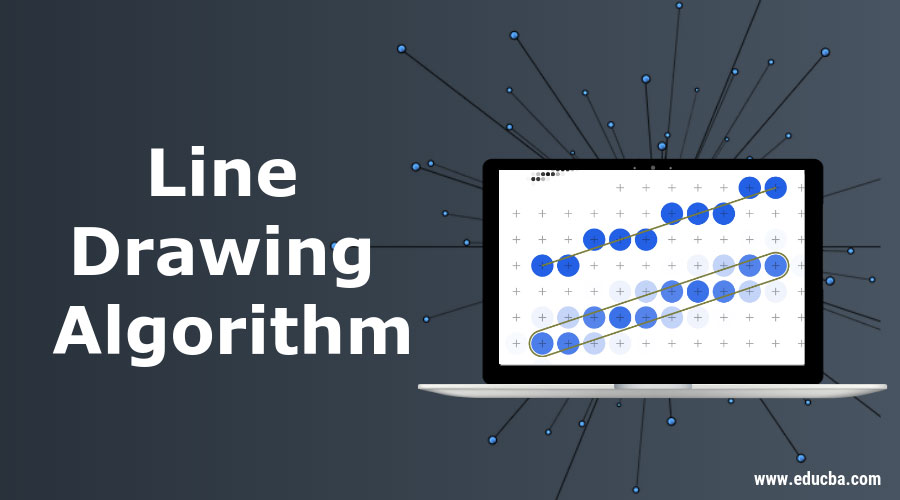Which algorithm is best for line drawing?

The execution of an algorithm results in many types of output. One of these outputs can be a graphical representation of an algorithm. Graphical algorithms are used to display graphics on digital displays made of pixels. The output of these algorithms can also be printed on paper with printers.
Moreover, the line drawing algorithm is one of the most popular graphical algorithms in programming. It is a basic graphical algorithm that, as an output, produces a slope line.
Two algorithms are most commonly used to produce a slope line on a digital medium The first algorithm is the Digital Differential Algorithm, and the second is the Bresenham line drawing algorithm.
Both of these algorithms generate similar output. However, there is a significant difference between the two algorithms based on their internal function.
So, let’s look at these two algorithms. to find out which of the two algorithms is best for line drawing.
Let’s get started!
Digital Differential Algorithm (DDA)
The Digital differential algorithm, or DDA, is a straightforward algorithm for line drawing. However, there is an extensive use of multiplication and division operations. Hence, it results in more complex problem-solving and increases the algorithm’s complexity.
Here are DDA’s basic steps to draw a line:
- The algorithm starts by inputting the initial and final coordinates. The line which the DDA will draw will be between these two coordinates. For example, x1,y1, and x2,y2 are the initial and final coordinates of the line that you want to draw. So, these coordinates will be the input for the algorithm.
- Now, the next step will be calculating the difference between these two coordinates. A subtraction operation simply procures it. So, the operation will look like this: dx = x2 – x1 and dy = y2 – y1.
- Now, based on the difference, the algorithm will calculate the number of steps required to draw the line. Moreover, it will also calculate the increment needed to get to the nearest pixel diagonally. In DDA, the division outcome is continuously rounded off to the nearest integer as a digital display follows the same structure of an x-y graph.
- At last, a paint method is used to keep drawing a small line after each step, eventually becoming the desired length line after the last step.
DDA works very well for its purpose, but still, there are a few Disadvantages of DDA. The way DDA works leaves some space for discrepancies.
For example, if DDA makes a minor mistake while rounding off the decimal to the nearest integer, it will make an error due to which the desired line will not be drawn. Moreover, the algorithm is also a little slower as it includes complex calculations.
Bresenham Line Drawing Algorithm
Now, the second algorithm for line drawing is the Bresenham line drawing algorithm. This algorithm was developed by Jack Elton Bresenham in 1962. Bresenham line drawing algorithm works Faster as compared to the DDA. The reason is the difference between the working of the Bresenham line drawing algorithm and DDA.
DDA, as you know includes the division and rounding off operations whereas the Bresenham line drawing algorithm uses addition, subtraction, and multiplication in the core of its function. This is why it works faster than DDA, leaving almost no gaps for errors.
Here is how the Bresenham line algorithm works:
- The Bresenham line algorithm starts its operation similar to the DDA. It takes the input of initial and final coordinates. Let’s say the initial coordinates are x0,y0, and the final coordinates are x1,y1.
- The next step is also the same as the DDA. It will take the coordinates and make a subtraction operation to find the difference.
- However, in place of division operation for calculating the increment, the Bresenham line algorithm uses a decision parameter which is as follows: 2* dy-dx.
- If the decision parameter is less than 0, then the algorithm increments y by 1 and updates the decision parameter: decisionParameter = decisionParameter + 2 * dy
- Else, it updates the decision parameter: decisionParameter = decisionParameter + 2 * (dy – dx) and increments x by 1.
What is the difference between training and development?
There are two terms often used in a corporate environment: training and Development. Training and Development of employees are two essential parts of a company. Both of these words somehow connected to the effectiveness and efficiency of the employees. But there is a difference between training and Development that you should know.
Training
Training is always a process within which an employee gains the knowledge and skills of a particular work, enabling the employee to do that work efficiently. The training is intended to make the employees better at what they do. Training can be implemented in a company when employees are joining. However, employees can also be trained between their jobs to increase their efficiency occasionally.
Moreover, if you look at the training process, you will find that it is a job-oriented process as employees are trained for their roles.
Development
Development, however, is a continuous process related to the all-rounder growth of employees. The Development of an employee can be done in various ways, whether by the employer, employee, or both.
The best example of Development is an employee learning something new that may or may not be helpful in his/her current job role but can help him/her develop.
Development is more career-oriented, enabling you to become good at your current job and get better opportunities.
Summing Up
Line drawing algorithms are meant to be the founding stone for programmers learning graphical input programming. However, it also creates programs to generate graphs from mathematical equations.
The Bresenham line algorithm is indeed more efficient and faster than DDA, but learning both of these algorithms is suitable for a programmer. Both algorithms help to learn the basics of graphical programming.






